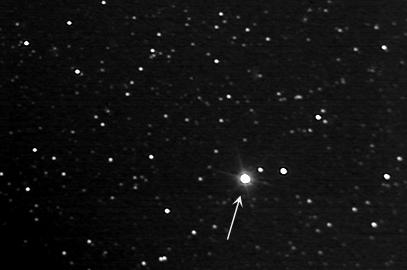The Pale Red Dot campaign that discovered Proxima Centauri b produced one of the great results of exoplanet detection. For many of us, the idea that a world of roughly Earth mass might be orbiting in Proxima Centauri’s habitable zone — where liquid water can exist on the surface — was almost too good to be true, and it highlighted the real prospect that if we find such a planet around the closest star to our own, there must be many more around similar stars. Hence the importance of learning more about our closest neighbors.
Which is why it’s so heartening to see that Pale Red Dot is by no means done. This morning, the team led by Guillem Anglada-Escudé (Queen Mary University, London) announced plans to acquire data from the European Southern Observatory’s HARPS instrument (High Accuracy Radial velocity Planet Searcher) in a new campaign to study not just Proxima Centauri in search of further planets, but also the red dwarfs Barnard’s Star and Ross 154.

Also involved will be a network of small telescopes performing photometric monitoring, including the Las Cumbres Global Observatory Telescope network, SpaceObs ASH2 in Chile, the Observatorio de Sierra Nevada and the Observatorio Astronómico del Montsec, both in Spain. But the star of the show continues to be HARPS, a high-precision spectrograph attached to the ESO’s 3.6-meter telescope at La Silla. HARPS is capable of detecting radial velocity motions down to 3.5 kilometers per hour, the pace of a leisurely evening walk.
Image: Lead author Guillem Anglada-Escudé speaking at a press conference in Garching, Germany about the 2016 discovery of Proxima Centauri b. Credit: ESO/M. Zamani.
Are there other planets around Proxima Centauri? The findings around TRAPPIST-1, all seven of them, give reason to hope that we’ll make further discoveries. As to Barnard’s Star, we still have no information about planets there, although for a time in the mid-20th Century, it was thought due to instrument error that there might be one or more gas giants orbiting the star. We know now that that isn’t the case, but the possibility of terrestrial-class worlds remains.
I’ll have more to say about that situation later in the week, but do want to note that the reason the Project Daedalus planners chose Barnard’s Star as their mission target was the supposition that those planets existed. Proxima Centauri would obviously have been a closer target.

Image: Barnard’s Star ca. 2006. Credit: Steve Quirk.
The M-dwarf Ross 154 is just under 10 light years from Earth, the nearest star in Sagittarius. That distance is closing at a good clip (in astronomical terms), so that the star will come to within about 6.4 light years in another 157,000 years. Like Proxima Centauri, Ross 154 is a UV Ceti-type flare star, producing major flares on the order of every two days. Given that flare activity in M-dwarfs is a major factor in the question of whether life can develop, finding planets close enough to be characterized by later space and ground telescopes would be a significant development, and the more systems the better to allow comparative analysis.
It will be fascinating to watch the new Pale Red Dot campaign develop, for these observations will be highly visible to the general public. While Pale Red Dot presented its results on Proxima b to the public only after extensive peer review, the observational data from the new campaign, beginning with Proxima Centauri, will be revealed and discussed in real time.
#ESOCastLight on #RedDots — the hunt for the nearest exoplanets #BiteSizedAstronomy #4K #UHD https://t.co/X1aFyJSHFO pic.twitter.com/9PU1f8TqSD
— ESO (@ESO) June 19, 2017
The scientists involved intend to maintain an active social media presence supported by various online tools. Keep an eye on the Red Dots Facebook page, the Red Dots Twitter account and the #reddots hashtag, as well as the main project page, where updates and featured contributions from the community will be posted on a regular basis.



Barnard’s and Ross 154 will be amazing additions to our near neighbour exoplanets. I wonder how they’ll get good data from an active UV-Ceti star?
For some historical perspective on attempts to find planets orbiting Barnard’s Star (including the claims by Peter van de Kamp), readers may wish to check out the following:
http://www.drewexmachina.com/2015/04/23/search-for-planets/
How far away is KOI8012? The Kepler final catalog states: KOI8012 stellar radius: 0.2Rs. KOI 8012.01 radius: 0.42Re, % insolation: 37, orbital period: 34 days. Keep in mind that this is JUST a planet CANDIDATE at present, but if it is CLOSE ENOUGH, it should be able to be CONFIRMED QUITE QUICKLY! Two OTHER new candidates ALSO stuck out, because of their Earth-like orbital periods and sun-like stars. KOI 8174 stellar radius: 0.76Rs, KOI 8174.01: orbital period: 295 days, % insolation: 70, radius: 0.67. KOI771 stellar radius: 0.8. KOI 7711.01: orbital period: 302 days, %insolation: 87: radius: 1.3. Unfortunately these two candidated are UNLIKELY to EVER be confirmed unless PLATO follows up on them.
Sorry, I meant KOI7711, NOT KOI 771.
Interesting news:new Kepler candidate KOI-7711.01 one of the most similar planes to Earth if confirmed
https://www.theweathernetwork.com/news/articles/keplers-newest-exoplanets-may-include-a-near-twin-of-earth/83321
https://www.nasa.gov/sites/default/files/styles/full_width_feature/public/thumbnails/image/press-web15_kepler_hz_planets_edit.jpg?itok=A8wPGhns
Proxima Centauri is also a UV-Ceti flare star, Adam, and we found Proxima b.
Yes, while Barnard’s Star is of a variable category known as BY Draconis (not UV Ceti); these are stars that show starspots, variations in luminosity and other activity. More on this later in the week.
Interesting article about the classification of planets, confirming the subdivision of smaller planets into the 2 categories (rocky) Earth-like planets and super-Earths, and (gaseous) mini-Neptunes.
Fulton, petigura et al., The California-Kepler Survey. III. A Gap in the Radius Distribution of Small Planets. The Astronomical Journal;
https://arxiv.org/abs/1703.10375
“We detect a factor of > 2 deficit in the occurrence rate distribution at 1.5-2.0 Re. This gap splits the population of close-in (P < 100 d) small planets into two size regimes: Rp < 1.5 Re and Rp = 2.0-3.0 Re, with few planets in between".
Also in:
https://www.sciencedaily.com/releases/2017/06/170619120238.htm
There appears to be "a striking gap between the groups of rocky Earths and mini-Neptunes". This gap is probably caused by the fact that beyond a certain threshold mass, a planet quickly gets a gaseous (H, He) envelope . Even only a 1% mass envelope greatly increases its diameter.
It would be interesting to learn whether this planetary size gap also exists for small planets in wider orbits. I would expect so: the mass threshold and runaway gas accumulation will also occur there. However, the quick loss of gas of small planets in the gap (by stellar radiation) would not occur as quickly in wider orbits.
Paul: I think this is worthy of a separate post (but you are probably already on it).
I am indeed! Out a bit later today.
Yes, Ross 154 (GJ 729) will be a very challenging target. Proxima is mostly classified as variable due to its flares but its rotation period is long so its photosphere seems to be changing rather smoothly (that was one of the things we suspected and ultimately allowed the ‘easy’ detection of Proxima b).
On the other hand Ross 154 is both a flare star and a fast rotator. We already have photometry, and all points out to a rotation period of ~2.8 days. That’s rather fast, BUT it might not be that bad because we should be able to distinguish temperate planets (orbits from 15-30 days) from this rather different time-scale, especially using the support of the quasi-continuous photometric monitoring.
On the other side of the table is Barnard star, which is the most RV and Photometrically stable M-dwarf we know (rotation period possibly longer than 100 days, bar very occasional flares). It should be old and venerable too given its quasi ‘halo’ kinematics.
Fingers crossed!
How soon will ESPRESSO come on-line? It may be that this is the only hope to cut through all of the noise expected from a fast rotating flare star.
Thanks for the additional insights, Guillem! I can’t wait to see how this unfolds in the months to come. And having grown up in the 60s and 70s with claims of planets orbiting Barnard’s Star (which have since proven to be spurious), I especially can’t wait to see what the HARPS team finds there.
I worry about fast rotating stars as they seem to grab all the orbital momentum in a system leaving little for planets.
I would be very surprised if neither Ross 154 nor Barnard’s star end up NOT having planets, as the discovery of Proxima b and Kepler mission results indicates a high prevalence of close-in terrestrial planets around M dwarf stars. There is another program involved in the search for M dwarf planets known as CARMENES, is this program separate from the Pale Red Dot campaign?
For readers interested in more information, feel free to check out this article with detailed background information on Proxima Centauri, Barnard’s Star and Ross 154
http://www.drewexmachina.com/2017/07/03/red-dots-the-search-for-nearby-exoplanets/
Guillem Anglada-Escude has just made a proposal to ESA for a space telescope 1000 times as sensitive as GAIA which would be able to reveal the TRUE MASS of Proxima b AND discover non-transiting planets orbiting nearby stars similar to TRAPPIST-1, for which optical RV measurements are impossible. He(and others) have dubbed the moniker “Theia” for their proposed mission.
The enduring mystique of Barnard’s Star
By Larry Sessions in Astronomy Essentials | July 1, 2017
Sometimes called Barnard’s Runaway Star, it’s one of the best known stars in the history of astronomy and in popular culture.
Full article here:
http://earthsky.org/astronomy-essentials/barnards-star-closest-stars-famous-stars
I remember when I first learned about Daedalus and how it would take 50 years to get to Barnard’s Star and examine those presumed Jovian class exoplanets. Then I learned that the BIS interstellar probe would only need 34 years to get to the Alpha Centauri system. As they were indicating that Daedalus might have the required technology available by the middle of the 21st Century, I held out hope that I might at least live to see it being built if not actually arrive at another star system.